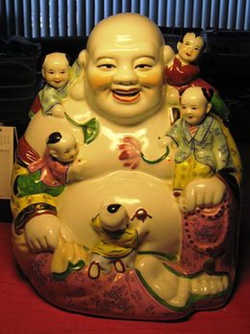Namarupa
Nāmarūpa is a dvandva compound in Sanskrit and Pali meaning "name (nāma) and form (rūpa)".
Nāmarūpa in Hinduism
The term nāmarūpa is used in Hindu thought, nāma describing the spiritual or essential properties of an object or being, and rūpa the physical presence that it manifests.
These terms are used similarly to the way that 'essence' and 'accidence' are used in Catholic theology to describe transubstantiation.
The distinction between nāma and rūpa in Hindu thought explains the ability of spiritual powers to manifest through inadequate or inanimate vessels - as observed in possession and oracular phenomena, as well as in the presence of the divine in images that are worshiped through pūja.
Nāma Rupatmak Vishva is the Vedanta (a school of Sanatana Dharma/Hinduism) term for the manifest Universe, viz.
The World as we know it. Since every object in this World has a Nāma and Rupa,the World is called Nāma Rupatmak Vishva.
The Paramātma (or Creator) is not manifest in this Nāma Rupatmak Vishva but is realized by a Sādhaka(student) by means of Bhakti (devotion), Karma (duty), Jnana (knowledge), Yoga (Union, a Hindu school), or a combination of all of these methodologies.
Nāmarūpa in Buddhism
This term is also used in Buddhism, to refer to constituent processes of the human being: nāma is typically considered to refer to psychological elements of the human person, while Rūpa refers to the physical.
The Buddhist nāma and rūpa are mutually dependent, and not separable; as nāmarūpa, they designate an individual being.
Namarupa are also referred to as the five skandhas.
Psychobio constituents
In the Pali Canon, the Buddha describes nāmarūpa in this manner :
|
"And what monks is name-&-form? Feeling, perception, intention, contact, & attention: This is called name. The four great elements, and the form dependent on the four great elements: This is called form. This name & this form are, monks, called name-&-form." |
|
Elsewhere in the Pali Canon, nāmarūpa is used synonymously with the five aggregates.
Empty of self
In keeping with the doctrine of anātman/anatta, "the absence of an (enduring, essential) self", nāma and rūpa are held to be constantly in a state of flux, with only the continuity of experience (itself a product of dependent origination) providing an experience of any sort of conventional 'self'.
Part of the cycle of suffering
Nāmarūpa is the fourth of the Twelve Nidānas, preceded by consciousness (Pali: viññāna; Skt.: vijñana) and followed by the six sense bases (Pali: saḷāyatana; Skt: ṣaḍāyatana).
Thus, in the Sutta Nipata, the Buddha explains to the Ven. Ajita how samsaric rebirth ceases:
- [Ven. Ajita:]
- [The Buddha:]
- This question you've asked, Ajita,
- I'll answer it for you —
- where name & form
- are brought to a halt
- without trace:
- With the cessation of consciousness
- they're brought
- to a halt.


